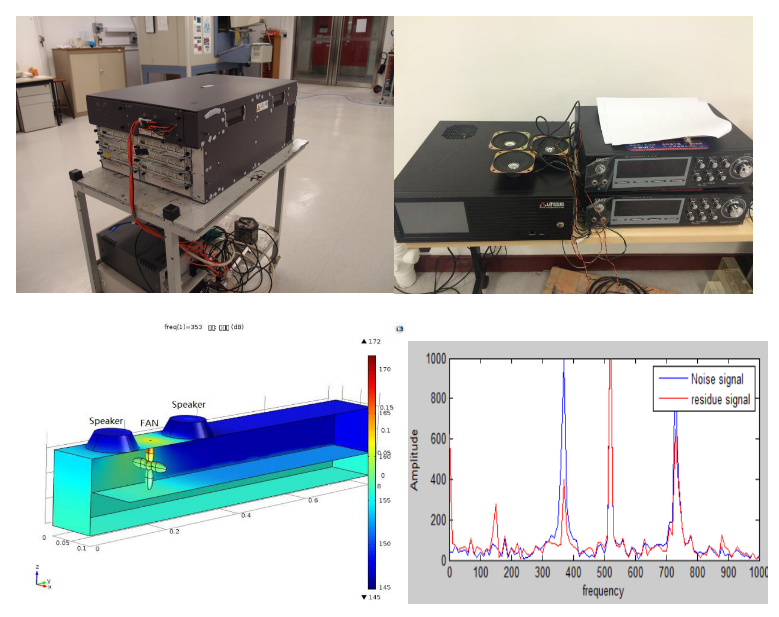1. Control of vibration and interior noise of vehicles
2. Design, analysis and optimization of industrial mufflers and silencers
3. Complex vibroacoustic systems with micro-perforates
4. Guided waves in thick-walled hollow cylinders for train axle inspection
8. Interior noise modeling, analysis and control for space structures
9. In-situ sound absorption of microperforated panels in compact acoustic environment
10. Suppression of flexural waves using resonators
11. Wavelets for acoustic and vibration analyses
12. Interior Noise Control Using Helmholtz Resonator
15. Semi-analytical modelling of Acoustic Black Hole structures
16. Design of noise insulation windows allowing natural ventilation
17. Active-Passive Approach for Axial Fan Noise Control in compact IT equipment
Control of vibration and interior noise of vehicles
Vibration and noise control inside an enclosure is a typical problem with great application potentials in both industry and civil construction engineering. Typical examples include the cabin noise of passenger vehicles, machinery noise in enclosures, noise in rooms and the damage of the payload inside aerospace launching body. These issues are directly related to our quality of life and determine the competitiveness of a large variety of industrial products. The two categories of products targeted by this project are aircraft and automobile. Following aspects are explored with an aim to reduce the vibration and interior noise of such vehicles: 1). Development of simulation and design tools; 2). Identifications of noise and vibration sources; 3). Passive control techniques including damping treatment and structural modifications; 4). Active control including the design of sensor/actuator and controllers. Various research projects in this area have received support from Bombardier Canada, Lord (Asia), De Havilland, Renault Vehicle Industries and China Academy of Space technology etc.
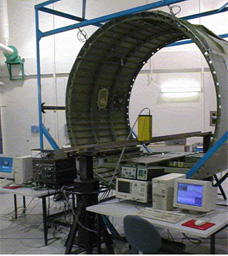
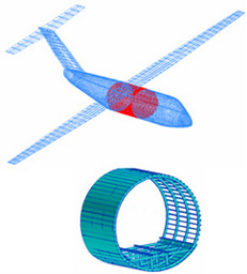
Design, analysis and optimization of industrial mufflers and silencers
Silencers are widely used in mechanical or ventilation systems for providing sound attenuation in a specific frequency range. In this topic, various categories of silencers and industrial mufflers are studied using substructuring modeling and optimization techniques. Reactive silencers with rigid internal partitions are studied for their parametric influences and attenuation mechanisms. With the introduction of microperforated panels,the hybrid attenuation mechanism (reflection + absorption) is revealed, and TL optimization for a particular frequency band is demonstrated. For the tuning and optimization of a silencer, the broadband TL realized by a number of cascade connected subchambers is investigated.
The characteristics of the subchambersprovide guidelines for their optimizations, and a desired broadband performance is achieved by connecting subchambers to tackle different frequency regions. In a case study, an engineering problem on reducing the noise radiation from a haul truck is presented, where the proposed subchamber design scheme is implemented to retrofit the truck muffler. The retrofitted muffler is experimentally verified with a better TL response in the design frequency of interest. Based on these, a multi-level approach for muffler design, analysis and optimization is proposed, which show interesting potentials to a wide range of industrial muffler design applications.
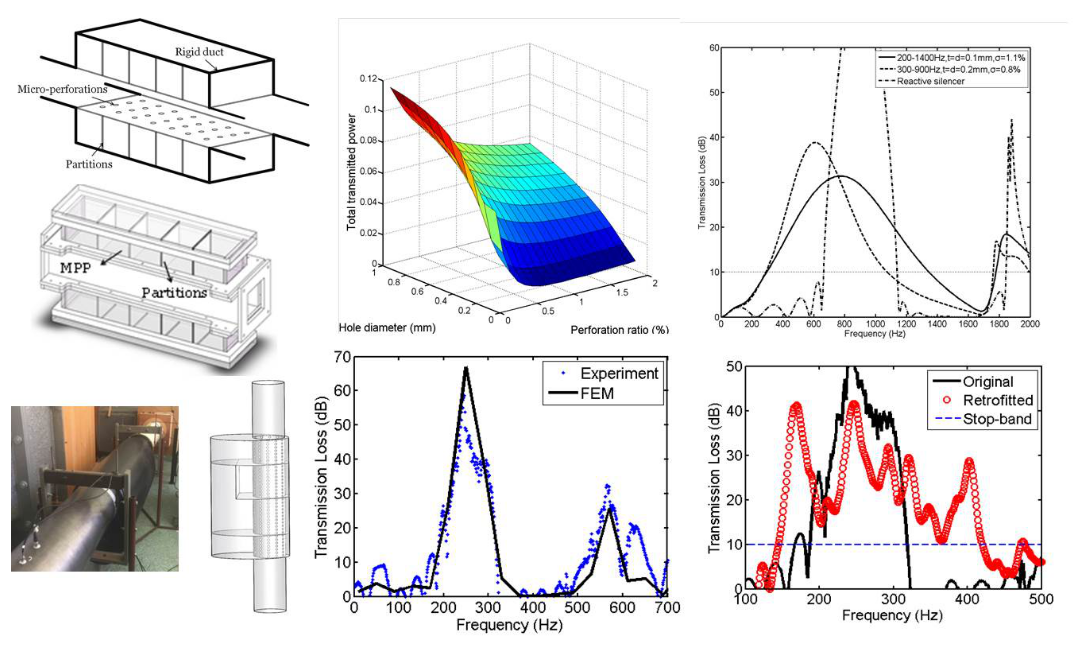
Complex vibroacoustic systems with micro-perforates
Vibroacoustic modeling of complex systems and their in-depth analyses are essential for the development of advanced noise control solutions. In this topic, efficient numerical tools are developed to deal with complex structural-acoustical couplings among various systems. A Compound Interface-Patch Transfer Function (CI-PTF) approach is proposed, highlighting its ability in handling mixed separations, such as those composed of rigid or flexible structures, apertures and MPPs. The convergence, accuracy, and efficiency of the developed numerical tools are thoroughly demonstrated. For typical applications such as closed/ventilation windows, duct silencers, their acoustic characteristics and performances are investigated using the proposed approach, providing efficient predictions and in-depth mechanism understandings.
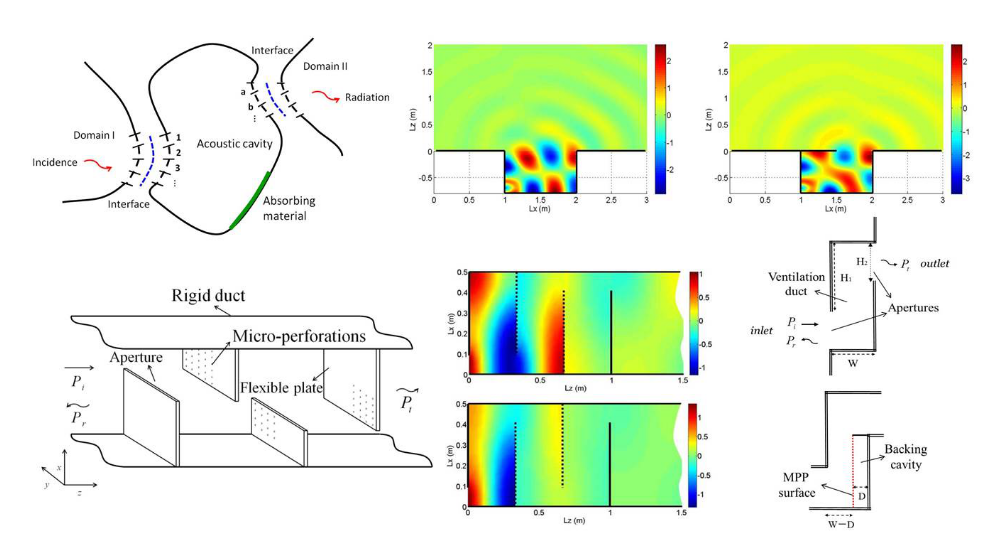
Guided waves in thick-walled hollow cylinders for train axle inspection
As of the most crucial components of high-speed trains, hollow axles require frequent inspections to prevent failures during their normal operation. Currently, evaluation of railway axles is based on common Nondestructive Testing (NDT) techniques such as visual inspection, magnetic particle inspection, eddy current or ultrasounds, which require dismounting of the bogie structure and inspection of the structure's surface in an off-line manner. An alternative approach is to utilize ultrasonic guided wave theory for in-service axle monitoring; however, this requires in-depth knowledge on elastic wave behavior in such structures. The aim of this project is to provide understanding on the elastic wave propagation in hollow cylindrical waveguides with thickness-to-wavelength ratio typical for railway axles, and based on the gained knowledge to develop a cost-effective, reliable monitoring strategy. The project involves analytical studies, numerical simulations using Local Interaction Simulation Approach (LISA) and experimental investigations.
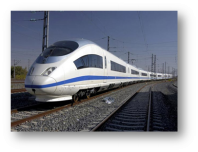
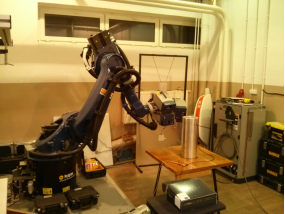
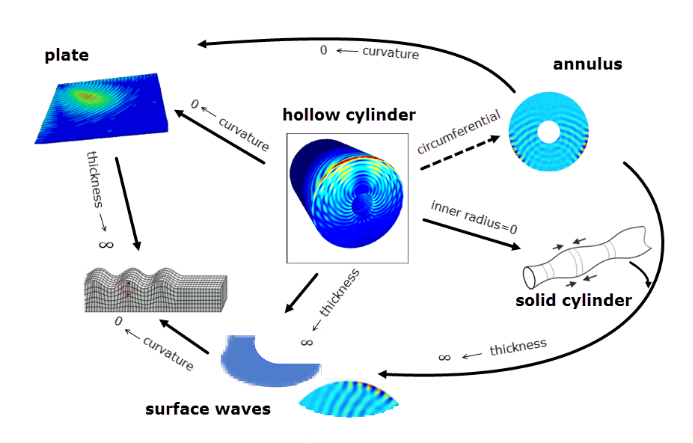

Preliminary results are published in:
Ziaja, A., Cheng, L., Su, Z., Packo, P., Pieczonka, L., Uhl, T., & Staszewski, W. (2015). Thick hollow cylindrical waveguides: A theoretical, numerical and experimental study. Journal of Sound and Vibration, 350, 73-90.
Non-ideal Acoustic Black Hole structures for energy focalization: A time-domain approach based on laser excitation technique
The importance of developing advanced structures with good vibration damping and noise insulation capability cannot be overemphasized for a wide variety of engineering applications. Compared with active control and traditional passive methods, Acoustic Black Hole (ABH) phenomenon takes advantages of the wave propagation properties of the structure-borne waves in thin-walled structures. The appealing ABH features inside a solid provide unique opportunities for structure-borne wave manipulation and achieve high efficiency for vibration control and energy harvesting. Investigation of the physical mechanism for ABH effect may have significant scientific value for advancing the state-of-the-art in vibration and noise control engineering. Following aspects are explored with an aim to investigate the physical mechanism of ABH effect: 1). FEM for general non-ideal 2-D ABH structures; 2). Time domain visualization of wave propagation; 3). Flexural ray properties of 2-D ABH structures; 4). Experimental time-domain approach based on laser excitation technique. (Collaborative project with Nanjing University of Aeronautics and Astronautics)
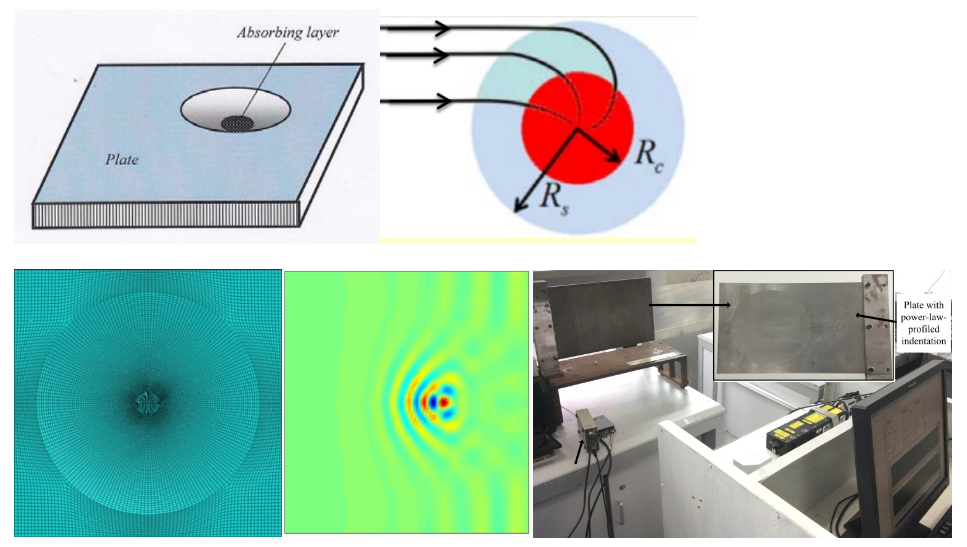
Pseudo-Excitation based Structural Health Monitoring using Sparse Virtual Element Boundary Measurement
With safety being a paramount factor for any engineering structures (such as land/water/air/space vehicles, civil infrastructure and heavy equipment), a large variety of Non-Destructive Evaluation (NDE) techniques have been well developed in the recent decades. Among existing methods, vibration based approach is one of the most studied techniques, due to their relatively low cost and potential to be used for on-line Structural Health Monitoring (SHM). Notably, the “pseudo-excitation” (PE) approach was recently proposed to provide a damage detection framework by evaluating the damage-induced perturbation to the local dynamic equilibrium. PE approach shows its advantages in that it requires no prior knowledge on the baseline signals, overall structural model or boundary conditions and so on. Following aspects are explored with an aim to improve PE approach: 1). Reducing measurement points. 2). Enhancing noise immunity capability. 3). Optimizing integration of sensor system (Metal-core Piezoelectric Fiber, MPF).
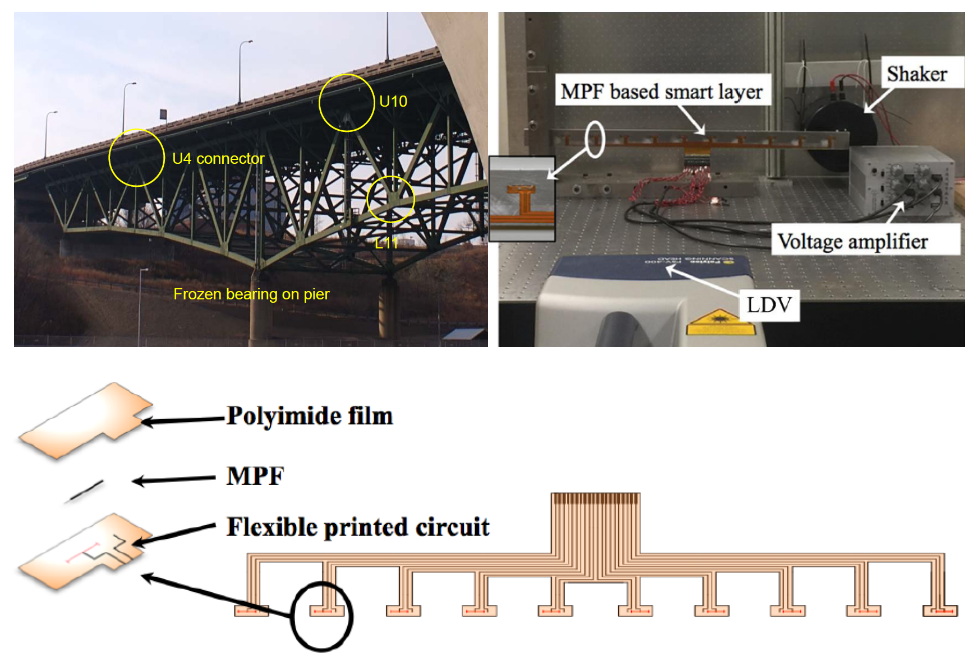
Semi-active vibration control based on synchronized switching damping and its application in aerospace engineering
Developing high-performance, light-weighted and low-power vibration and noise control systems is of great importance for various engineering problems, especially for aerospace industry. Compared with passive and active vibration control methods, Semi-active Synchronized Switch Damping (SSD) approach using piezoelectric actuators shows appealing features in vibration control because no proportional power amplifiers and high-performance digital signal processing units are required, non-sensitive to the variation of the system parameters, and the control system is more compact. Following aspects are explored with an aim to improve the control performance of SSD methods and to promote its application in aerospace engineering: 1). Development of modelling and analysis methods; 2). Optimization of switch control strategy for multimodal and wide-band control; 3). Improvement of driving capability on PZT by circuit design; 4). Applications of SSD technologies to aerospace engineering, not limited to structural vibration, but also in flow-structure coupling problems and structural noise suppression. (Collaborative project with Nanjing University of Aeronautics and Astronautics)
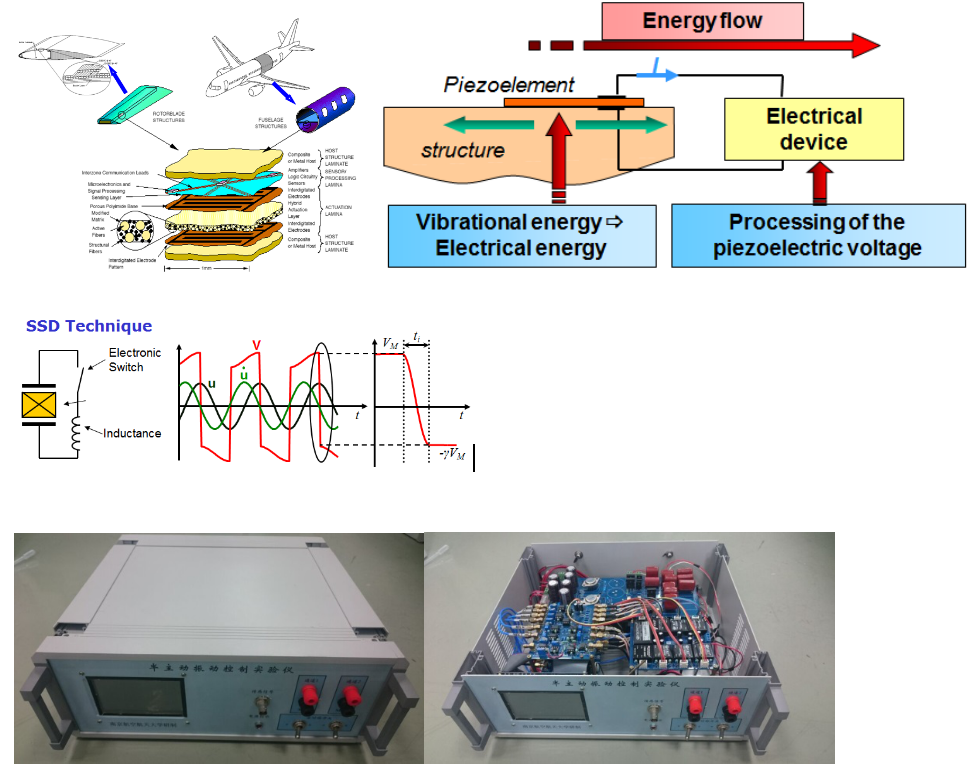
Interior noise modeling, analysis and control for space structures
Insufficient acoustical awareness would pose potential risks, both physically and psychologically, to astronauts. Acoustical issues are being considered during the design stage of spacecraft especially for long-range inhabited space programs, requiring a systematic noise control plan. The design of a suitable and effective noise control strategy, in reality, is a complex task. Practical solutions depend on a good understanding of the acoustic field surrounding astronauts, features of the acoustic sources and numerous restrictions for implementation. A credible noise control plan, in general, consists of two parts: noise prediction and control implementation. Under the joint laboratory with China Academy for Space Technology, this project explores various issues related to the modelling, analyses and control of interior noise. The project is first focused on developing a vibro-acoustic modelling technique based on a sub-structuring concept, which is flexible in dealing with complex systems, versatile in hosting various conventional modelling techniques, and efficient in tackling system modifications. Second we investigate two typical noise control devices, i.e. Micro-perforated Panel and Helmholtz Resonators, for dealing with broadband and tonal noise inside the cabin, respectively.
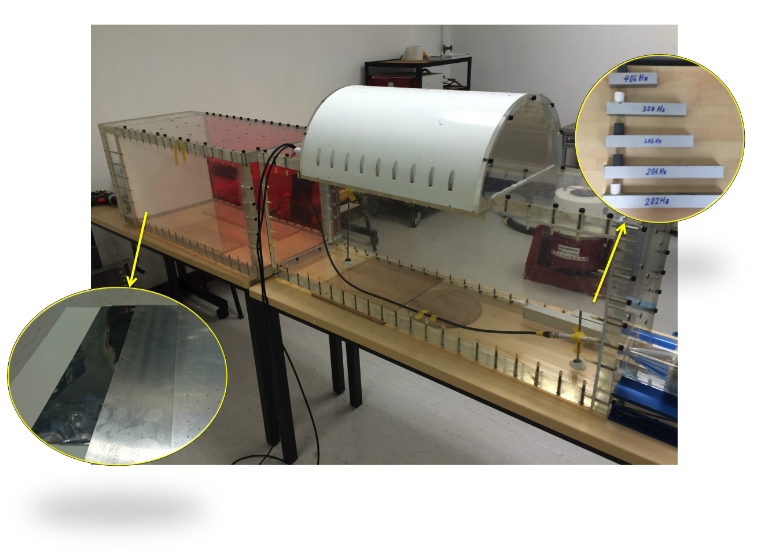
In-situ sound absorption of microperforated panels in compact acoustic environment
Microperforated Panels (MPPs) are conventionally used as a sound absorption material in room acoustic problems to provide broadband absorption. The non-fibrous property of MPPs makes themselves a promising noise control device in compact mechanical systems, like vehicle cabins, ventilation ducts, etc, where the acoustic fields are different from those in room acoustic situations. The in situ sound absorption properties of Microperforated Panel Absorbers (MPPAs) with two backing configurations, one containing an entire air volume and the other having a honeycomb structure at the back, are investigated. Although the standard impedance tube measurements predict very similar sound absorption coefficient curves, they in fact exhibit drastically different in situ sound absorption behaviors when placed inside a compact acoustic enclosure. The difference arises from the acoustic coupling, of the incident field and the backing cavity field, over the MPP surface. An in-depth understanding of this coupling mechanism enables the design and placement of MPPA for better sound absorption. The in-situ sound absorption of MPP in coupled vibroacoustic systems is investigated, which shows that they should be treated as an integrate part of the system.
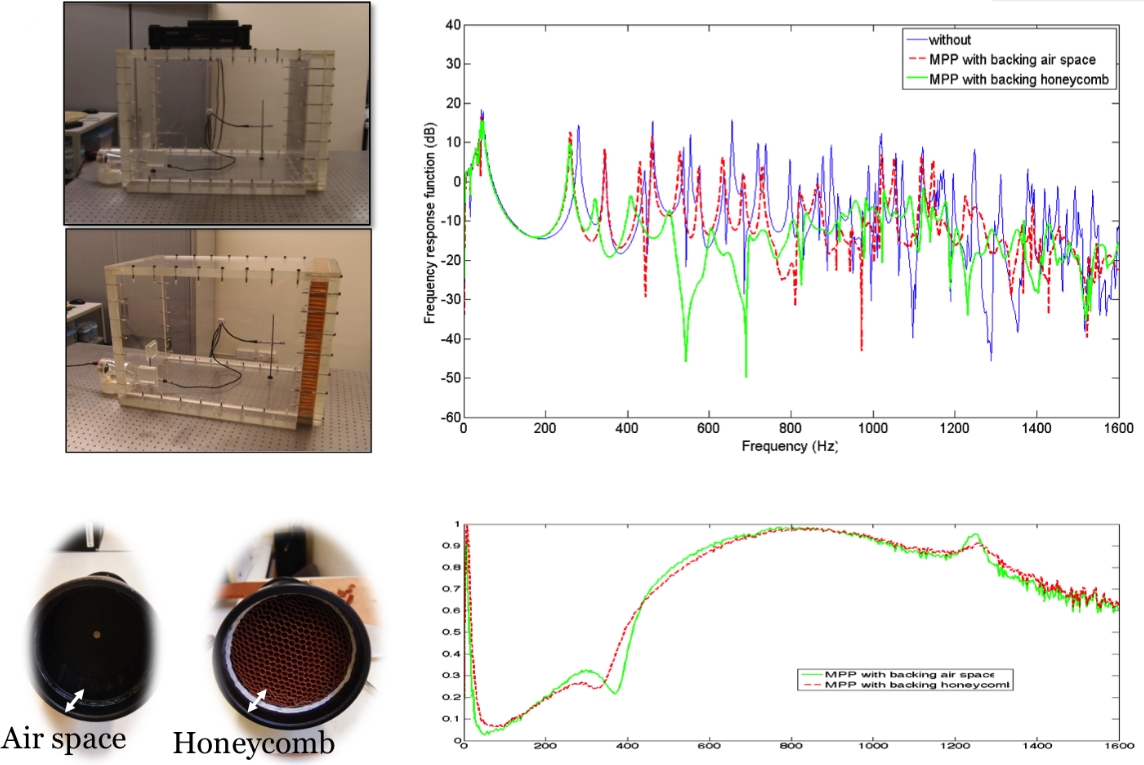
Suppression of flexural waves using resonators
Beams and plates are major structural components in numerous mechanical systems. Subject to excitation, they may become major noise sources, which radiate acoustically into the surrounding acoustic media, creating noise problems. Efforts are being made for suppressing unwanted vibrations by introducing local resonators (dynamic absorbers) to the structures. Traditionally designed resonators are bulky and heavy, limiting their applications where weight and space are of concern. A metamaterial, consisting of periodically arranged small-sized local resonators, can potentially create band gaps at the wavelength below that associated with the periodicity of the structure, opening up a new research area for the noise and vibration control field. In view of its periodicity, the dynamic characteristics of a metamaterial could be derived from the analysis of a local structural unit with proper periodic boundary conditions. In the low frequency range where local resonant phenomenon dominates, the way in which the local resonators are interacting with each other needs to be understood. This issue is being investigated in this project.
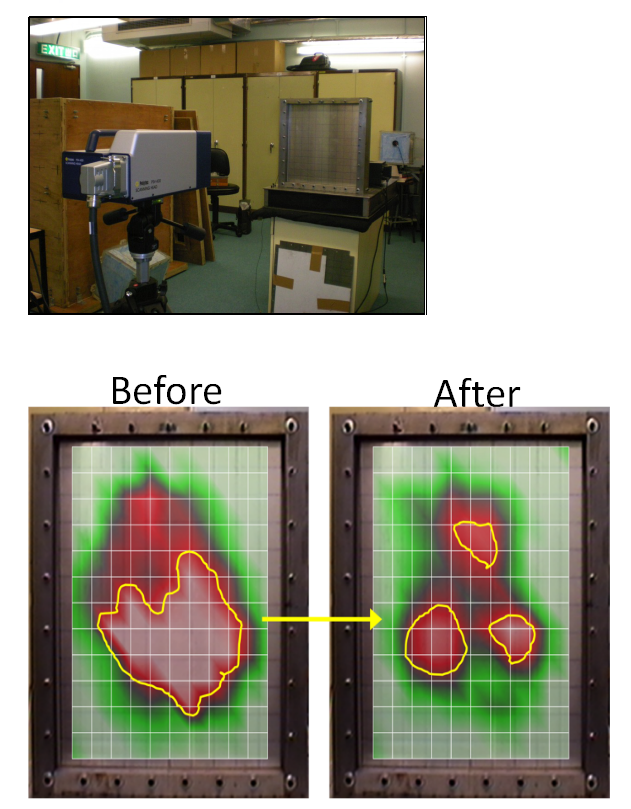
Wavelets for acoustic and vibration analyses
Wavelets are shown to possess some appealing features such as compact support, flexible scaling and translation, and the ability to approximate any square integrable function on the real axis. In this topic, wavelets have been used in the analyses of various acoustic and vibration problems, especially for inner sound field calculation, boundary shape optimization of acoustical cavity, and structural vibration simulation. In the inner sound field calculation, it was discovered that, owing to their compact support and strong oscillation property, wavelets possess extraordinary fitting ability to approximate sound pressure variations, especially at places where significant changes are present (such as around corners or along the boundary which is very close to the noise sources). Under multi-section Galerkin discretization framework, the above method can be applied to various boundary conditions from vary soft to rigid wall, and enventually coupled to multiple media fields such as porous materials. Different from traditional local basis element method, such as FEM/BEM, the wavelet-based method under development expresses the unknown field in a global way, conducive to various boundary shape optimization problems by avoiding the costly meshing process in conventional mesh-based methods. Due to the sparse nature of matrices arising from the discretization of structural vibration equations, the wavelets is also used to model structural vibrations in a very large wave number region.
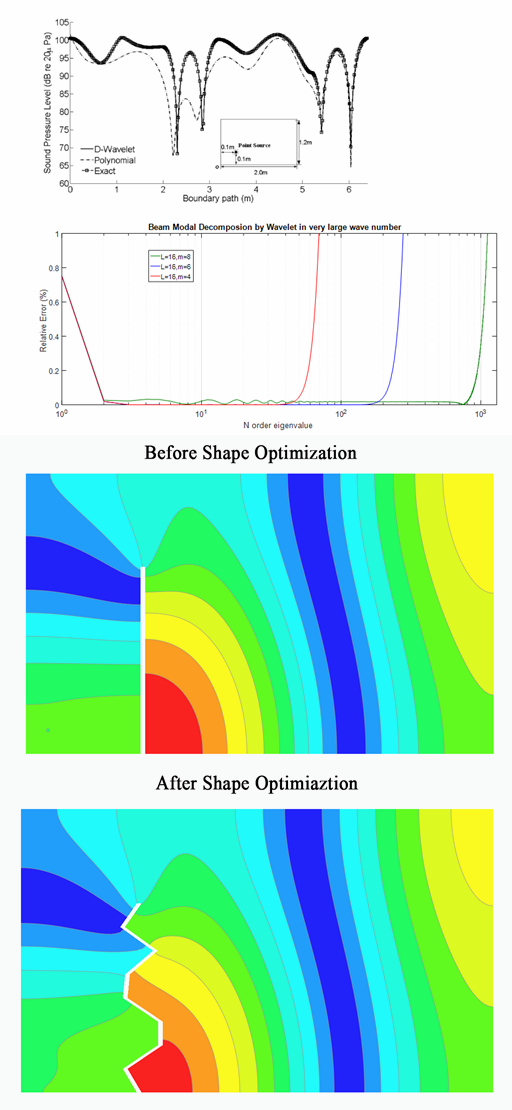
Interior Noise Control Using Helmholtz Resonator
Helmholtz resonator are often used as a narrowband noise control device in an acoustic enclosure. Classical Helmholtz resonators, consisting of a bulbous body and a long neck, are hard to integrate into small enclosures or thin walls. As an alternative, long T-shaped acoustic resonators are being investigated in this project, and are found to be a promising choice for noise control in small enclosures. Generally speaking, the performance of a resonator can be optimized through adjusting Helmholtz frequency, the internal resistance and the installation locations. The latter is of great influence on the coupling between the resonator and an enclosure, depending on the modal characteristic of the enclosure. Through the internal resistance design, the acoustic energy reduction can be maximized, by balancing the dual working process: energy radiation and energy dissipation. The overall optimization usually involves all the three aspects.
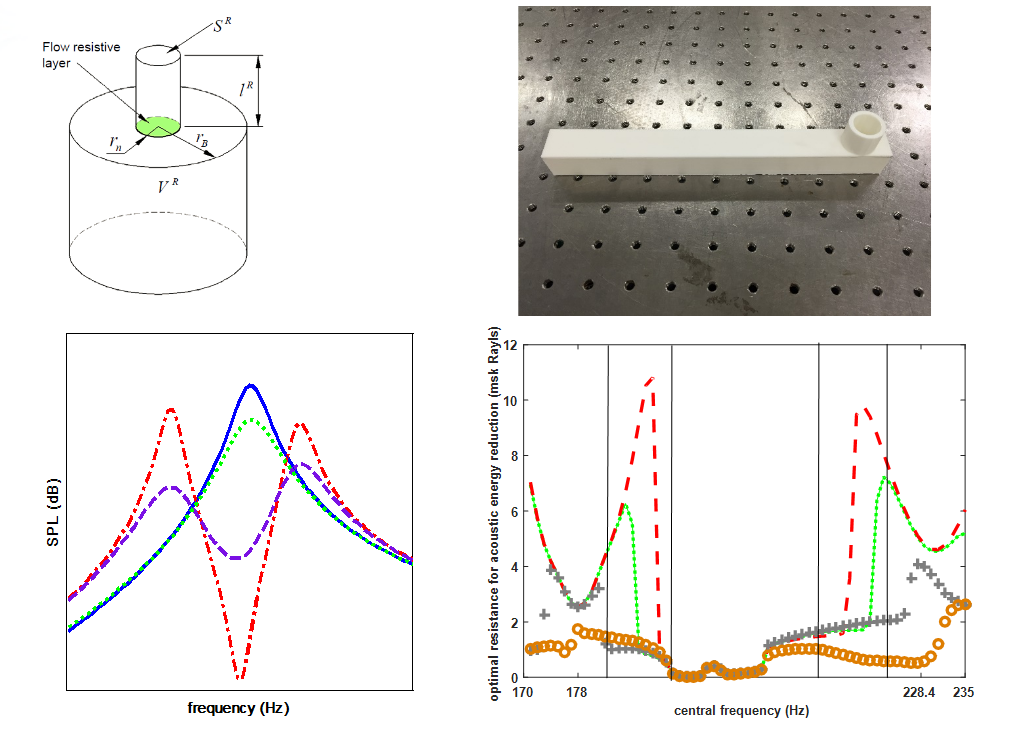
Nonlinear Third-harmonic Shear-horizontal Waves for Structural Health Monitoring through Incipient Defect Detection
Structural health monitoring (SHM) is an emerging technology aiming at the on-line diagnosis of damages inside structures during their operation. Very recent work reveals that nonlinear third-harmonic shear horizontal (SH) waves are sensitive to micro and incipient defects, pointing at the possibility of achieving early detection of damage or even its precursor. The study is expected to deepen the understanding of the underlying physics on one hand, and to explore the application feasibility of the nonlinear SH waves for SHM applications on the other hand. Based on the purposes, following aspects are explored: 1. To establish a theoretical model to investigate wave propagating characteristics including the adhesive nonlinearity for guiding practical design of SHM system. 2. To understand the relationship among the plastic deformation and measured nonlinear parameters for demonstrating the high-sensitivity of the third-harmonic SH waves with plastic deformation. 3. To propose a comprehensive SHM methodology based on third-harmonic SH waves for diagnosis of incipient and micro-damages and to experimentally demonstrate its feasibility.
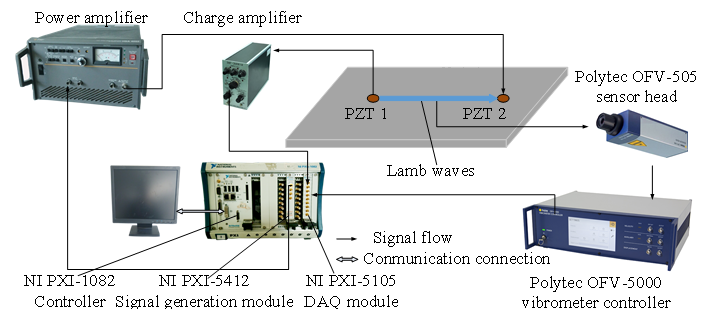
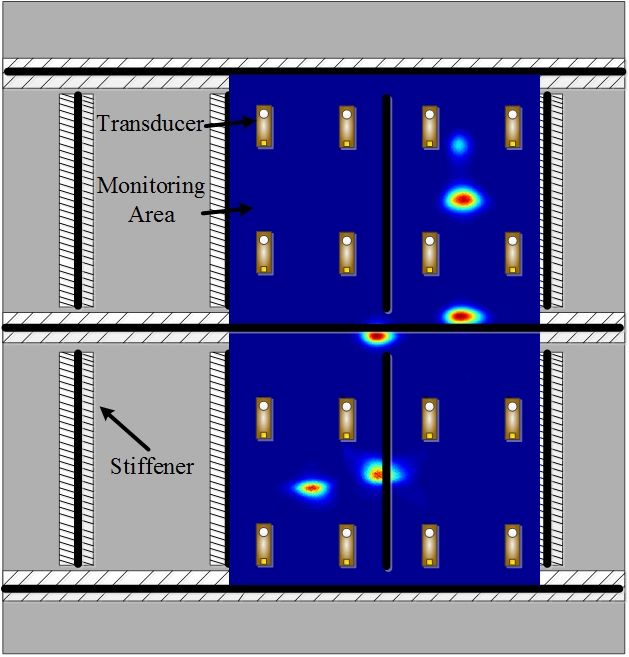
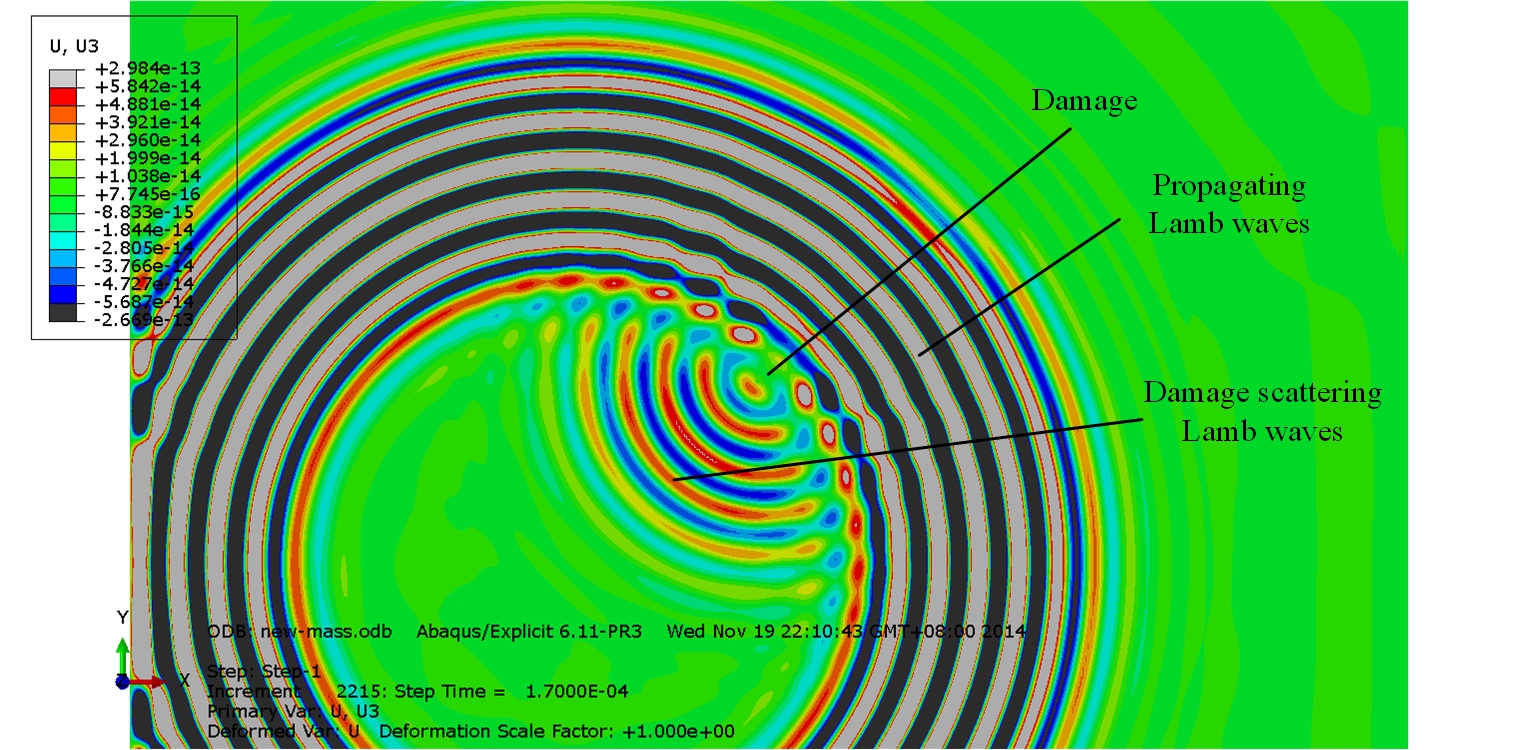
Semi-analytical modelling and analyses on non-linear elasto-acoustic wave propagation for SHM applications
Structural health monitoring (SHM) is an emerging technology aiming at the on-line diagnosis of damages inside structures during their operation. Successful implementation of SHM allows enhancing the safety and evaluating residual lifetime of structures in service, in consequence, avoiding exorbitant maintenance costs to a large extent. As a key contributing and undesirable nonlinear factor, the adhesive nonlinearity is investigated, including its effect on the nonlinear second-harmonic Lamb waves and nonlinear third-harmonic shear horizontal (SH) waves. Following aspects are explored with an aim to reduce the interference of bonding layer on SHM: (1). Establishment of theoretical model; 2). Determination of higher-order material parameters; 3). Collection and separations of wave signals; 4). Application to SHM using nonlinear higher-order waves.
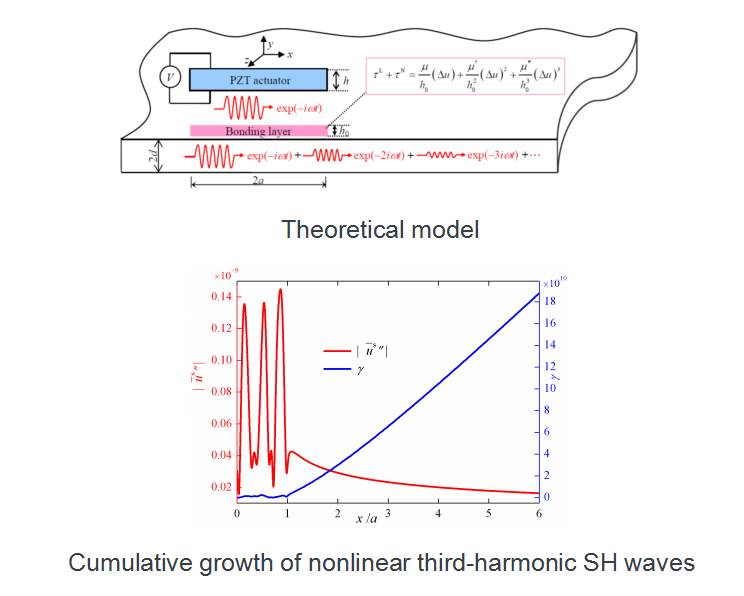
Semi-analytical modelling of Acoustic Black Hole structures
Acoustics Black Hole (ABH) effect shows promising features for potential vibration control, sound radiation control and energy harvesting applications. ABH effect is to gradually reduce the local phase velocity of the flexural waves by reducing structure thickness according to a power-law profile (with power no less than 2), achieving zero reflection in the ideal scenario thus creating energy concentration at the tip end. In this way, only a very small amount of damping materials is required at the energy focalization region to achieve efficient damping of flexural waves. Other energy harvesting elements can also be used within the energy focalization region for energy harvesting. However, the addition of vibration control or energy harvesting elements may affect the formation of the ideal ABH effect through their coupling with the host structure. Meanwhile, topological or system optimizations may be needed to achieve the maximum performance. In this project, we establish a very flexible Semi-analytical model based on energy method, which allows the consideration of the full coupling between the host ABH structure and various control or energy-harvesting elements to guide ABH structural design for various applications.
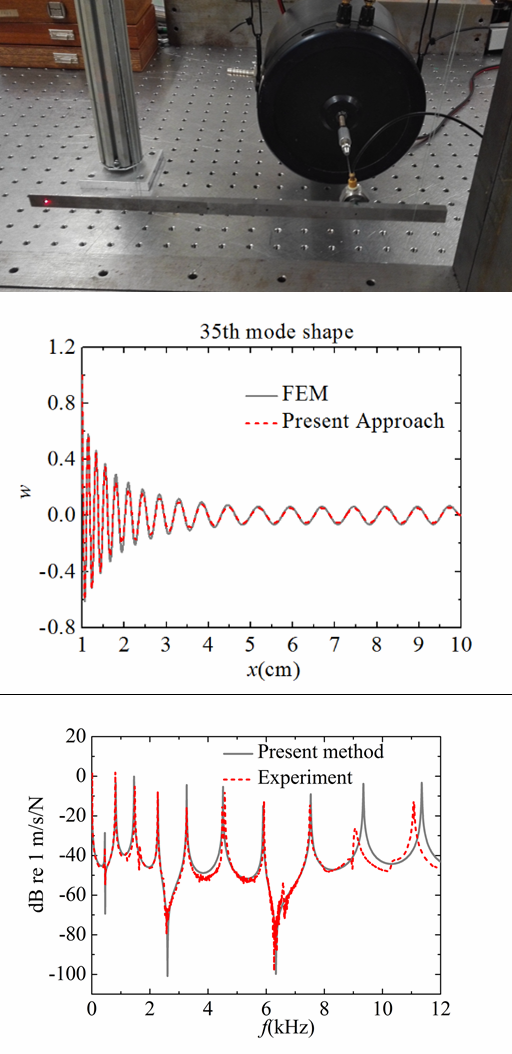
Design of noise insulation windows allowing natural ventilation
Noise from road traffic and other sources affect our health and pollute the environment. Close windows are effective for noise insulation but prohibit air ventilation. In this project, we explore a new class of windows called acoustic ventilation window system which will reduce traffic noise penetration whilst allowing natural ventilation at the same time. This can be achieved by a proper configuration design, combining both reactive and dissipative effect of the system. In this project, the following aspects are explored: 1) Literature review on some existing noise mitigation measures. 2) Window design. 3) Numerical simulations to identify important design parameters. 4) Build up an experimental model to validate and assess the performance against different specifications.
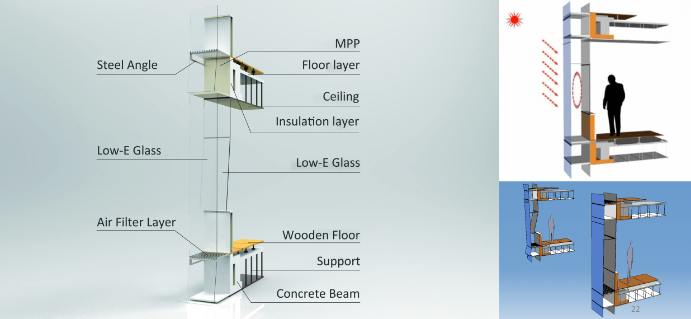
Active-Passive Approach for Axial Fan Noise Control in compact IT equipment
Axial fan is one of the major devices used for cooling in Information Technology (IT) equipment. The increased computation power of IT equipment is accompanied by increasing amount of heat produced during the operation, thus requiring the cooling fan to be run at higher speed. This inevitably leads to the generation of more noise, which, in turn, draws the concern of IT equipment manufacturers. A hybrid approach is developed to reduce the noise generated by the axial fan in a commercial IT product. It consists of two parts: 1) Passive noise control approach is made by lining sound absorption material in the ventilation duct. Concerning the exceptional working environment, conventional porous or fibrous materials are not appropriate for the equipment. As a solution, Micro-perforated Panel, which is fibrous free, is used to provide sound absorption in the duct. 2) an active noise control approach is developed using FXLMS algorithm to deal with the BPF (Blade Passing Frequency) fan noise. The project is partially supported by Huawei.
